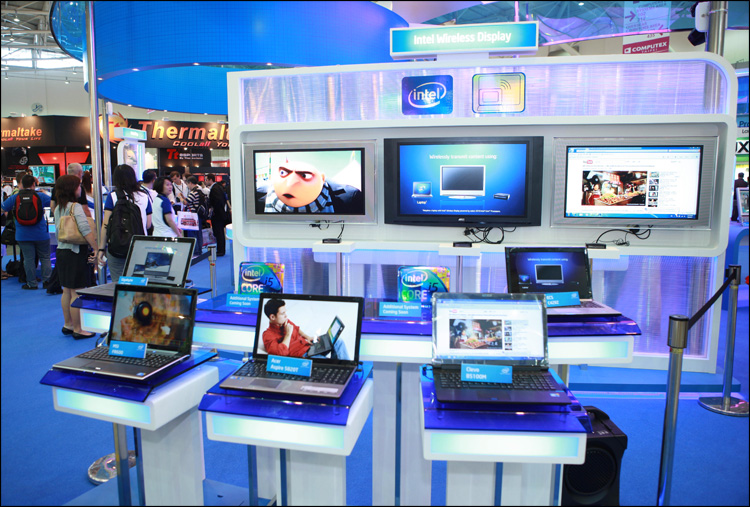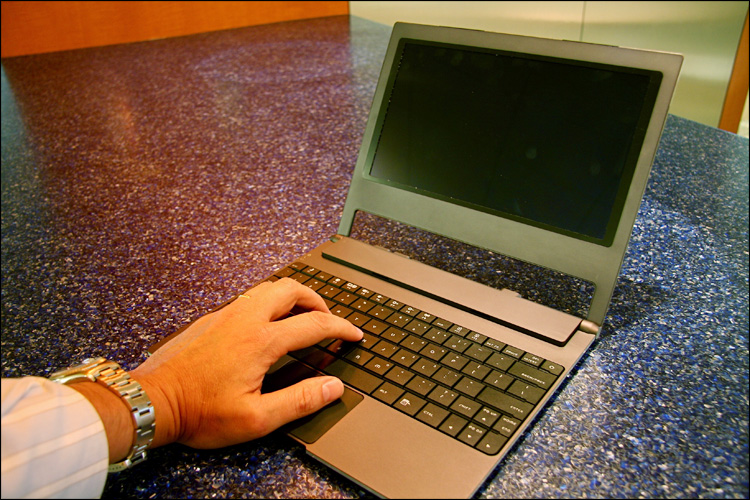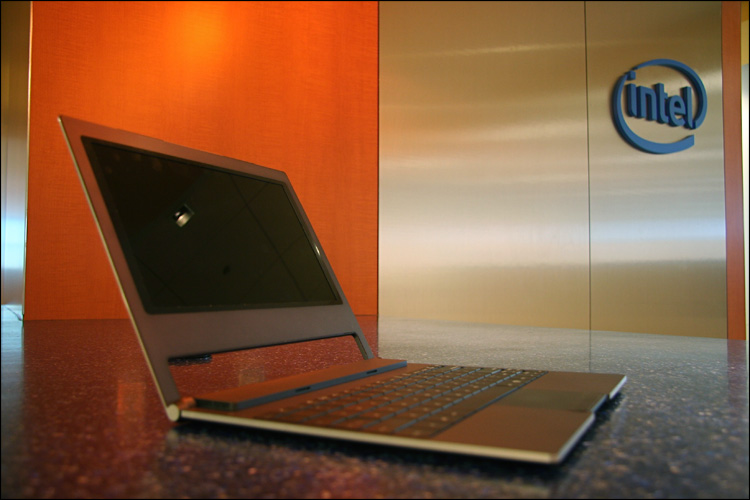What Intel will show at Computex 2010
In the capital of Taiwan (and this is Taipei), it is so full of everything related to IT, but in the first five days of the calendar summer, high-tech IT concentration is especially high, because there is an interesting international computer exhibition with the most advanced achievements. I would like to be there in these hot days ... but it didn’t come up) Therefore, I hope (and even surely) that someone will highlight the most interesting novelties in the very near future.

And I, using intelligence data, will tell you what Intel showed and will show at the exhibition.
All the information came in a metal capsule sealed on both sides a day before the exhibition, but it took two days to decipher the information and create a single post from it - in general, we had to pretty much try. Far from all succeeded; therefore, the information was presented not in a single text, but in the form of separate thematic paragraphs.
')
The exhibits from Intel were expectedly presented in several directions at once: client personal computers and smart devices, ultra-portable computers, wireless technologies, various embedded solutions and all kinds of software. But most of all activity, of course, was around the level of Intel Atom processors.
Over the past 45 days, the company has managed to bring the mobile Intel Atom processors beyond their typical hardware types, like netbooks (sales of which, by the way, exceeded 50 million in two years!) And nettops. In the near future, mobile processors will appear in a whole series of various devices, including various pocket gadgets and desktop systems, interactive vending machines, TV set-top boxes for the smart home and other onboard infotainment systems (IVI). In most cases, everything will work on the new MeeGo platform, which will make it possible to achieve a single interface and usability.

By the way, Intel Atom themselves will be replenished in the very near future (already this month) - dual-core processors will be launched into production. Netbooks already have Intel Atom N455 and N475 chips (with DDR3 memory support), while the D525 and D425 models will be available from June 21 and will most likely be intended for entry-level desktops and all-in-one systems. one ”(SSF, Small Form Factor).
Here is another interesting news. By 2011, the planned appearance of optimized for tablets and netbook platform Intel Oak Trail . In its arsenal, full support for high-definition video, reducing up to 50% of power consumption, as well as a wide range of compatible software, including MeeGo, Windows 7 and software from Google. In the fall of this year, ASUS will be the first of the OEM partners to start pre-installing a client for Intel AppUp Center on netbooks - called the ASUS App Store .
Speaking about the company's plans for the near future, David Perlmutter , vice president and general director of the Intel Architecture Group (David Perlmutter; unusual surname, yes?), Was holding the world's thinnest netbook. The new Canoe Lake , which is only 14 mm thick (almost twice thinner than the usual budget netbooks on the market), works on the upcoming dual-core processor Pine Trail and doesn’t heat up at all.


In addition to the netbook, David also talked about the technology of wireless transmission of video signals to Intel Wireless Display devices, as well as Intel Core chips with the new generation Sandy Bridge microarchitecture, which will be announced at the end of 2010.
Intel Wireless Display technology was introduced in January this year at CES 2010 - as part of a completely new family of Intel Core processors. In short - now, in order to watch photos or a movie with friends, you don’t have to stick around your laptop screen - you can transfer the image (up to high-definition video) to ordinary TVs, and do it all over the wireless interface, within WiFi. And they say that the technology also allows you to listen to music files and Internet radio on your home stereo.
About the agreement with Google, Sony and Logitech and the subsequent release of "Smart TVs" Smart TV on Google Android OS ... and not, I already told you . However, as well as about the company's plans for a new mobile platform Moorestown , which includes "system-on-chip" based on Intel Atom Z6xx (codename Lincroft), Intel Platform Controller Hub (PCH) MP20 (Langwell) and Mixed Signal chips IC (Briertown) with wireless options, including 3G / HSPA support. All this may very soon be inside various tablets or mobile devices such as smartphones.
Since July, sales of devices will begin on new ULV processors, which I recently wrote about . The market will be about 40 devices from famous companies, including Acer, ASUS, Lenovo and MSI.

In addition to mobile processors, several desktop processors with an unlocked multiplier — the Intel Core i7-875K , i7-980X, and i5-655K — were introduced to the general public. In fact, these are variants of similar processors, but with additional settings, and therefore with additional potential, something that all kinds of enthusiasts love.
And finally - WiMAX 2.0 , based on the IEEE 802.16m standard. A group of leading players in the WiMAX market (including Intel) launched the WiMAX 2 Collaboration Initiative — by the end of the year, the WiMAX Forum will provide specifications for the certification process. This will enable many companies to accelerate the introduction of new functions and to achieve maximum compatibility of networks.

On this I, perhaps, take my leave. It would seem ... some 5 days (of which incomplete two have passed at the time of writing this article), and already so much has been shown and told, all from just one company! Well, who's next? )
Do not hesitate to join the blog of Intel on Habré. Successes!

And I, using intelligence data, will tell you what Intel showed and will show at the exhibition.
All the information came in a metal capsule sealed on both sides a day before the exhibition, but it took two days to decipher the information and create a single post from it - in general, we had to pretty much try. Far from all succeeded; therefore, the information was presented not in a single text, but in the form of separate thematic paragraphs.
')
The exhibits from Intel were expectedly presented in several directions at once: client personal computers and smart devices, ultra-portable computers, wireless technologies, various embedded solutions and all kinds of software. But most of all activity, of course, was around the level of Intel Atom processors.
Over the past 45 days, the company has managed to bring the mobile Intel Atom processors beyond their typical hardware types, like netbooks (sales of which, by the way, exceeded 50 million in two years!) And nettops. In the near future, mobile processors will appear in a whole series of various devices, including various pocket gadgets and desktop systems, interactive vending machines, TV set-top boxes for the smart home and other onboard infotainment systems (IVI). In most cases, everything will work on the new MeeGo platform, which will make it possible to achieve a single interface and usability.

By the way, Intel Atom themselves will be replenished in the very near future (already this month) - dual-core processors will be launched into production. Netbooks already have Intel Atom N455 and N475 chips (with DDR3 memory support), while the D525 and D425 models will be available from June 21 and will most likely be intended for entry-level desktops and all-in-one systems. one ”(SSF, Small Form Factor).
Here is another interesting news. By 2011, the planned appearance of optimized for tablets and netbook platform Intel Oak Trail . In its arsenal, full support for high-definition video, reducing up to 50% of power consumption, as well as a wide range of compatible software, including MeeGo, Windows 7 and software from Google. In the fall of this year, ASUS will be the first of the OEM partners to start pre-installing a client for Intel AppUp Center on netbooks - called the ASUS App Store .
Speaking about the company's plans for the near future, David Perlmutter , vice president and general director of the Intel Architecture Group (David Perlmutter; unusual surname, yes?), Was holding the world's thinnest netbook. The new Canoe Lake , which is only 14 mm thick (almost twice thinner than the usual budget netbooks on the market), works on the upcoming dual-core processor Pine Trail and doesn’t heat up at all.


In addition to the netbook, David also talked about the technology of wireless transmission of video signals to Intel Wireless Display devices, as well as Intel Core chips with the new generation Sandy Bridge microarchitecture, which will be announced at the end of 2010.
Intel Wireless Display technology was introduced in January this year at CES 2010 - as part of a completely new family of Intel Core processors. In short - now, in order to watch photos or a movie with friends, you don’t have to stick around your laptop screen - you can transfer the image (up to high-definition video) to ordinary TVs, and do it all over the wireless interface, within WiFi. And they say that the technology also allows you to listen to music files and Internet radio on your home stereo.
About the agreement with Google, Sony and Logitech and the subsequent release of "Smart TVs" Smart TV on Google Android OS ... and not, I already told you . However, as well as about the company's plans for a new mobile platform Moorestown , which includes "system-on-chip" based on Intel Atom Z6xx (codename Lincroft), Intel Platform Controller Hub (PCH) MP20 (Langwell) and Mixed Signal chips IC (Briertown) with wireless options, including 3G / HSPA support. All this may very soon be inside various tablets or mobile devices such as smartphones.
Since July, sales of devices will begin on new ULV processors, which I recently wrote about . The market will be about 40 devices from famous companies, including Acer, ASUS, Lenovo and MSI.

In addition to mobile processors, several desktop processors with an unlocked multiplier — the Intel Core i7-875K , i7-980X, and i5-655K — were introduced to the general public. In fact, these are variants of similar processors, but with additional settings, and therefore with additional potential, something that all kinds of enthusiasts love.
And finally - WiMAX 2.0 , based on the IEEE 802.16m standard. A group of leading players in the WiMAX market (including Intel) launched the WiMAX 2 Collaboration Initiative — by the end of the year, the WiMAX Forum will provide specifications for the certification process. This will enable many companies to accelerate the introduction of new functions and to achieve maximum compatibility of networks.

On this I, perhaps, take my leave. It would seem ... some 5 days (of which incomplete two have passed at the time of writing this article), and already so much has been shown and told, all from just one company! Well, who's next? )
Do not hesitate to join the blog of Intel on Habré. Successes!
Source: https://habr.com/ru/post/95288/
All Articles